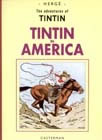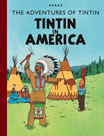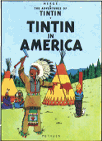Tintin in America

- Black & white facsimile edition / original version. Hardback.

- Colour facsimile edition / 1945 re-drawn version. Hardback.

- Colour edition / 1945 re-drawn version. Hardback. Paperback.
- Tintin © Hergé/Moulinsart.
Original French title
Tintin en Amerique
Publication history
First published in Le Petit Vingtième between 3 September 1931 and 20 October 1932.
Published in book form in 1932 (black and white, 120 pages).
Redrawn in 1945 (except page 62, frame 2).
English edition
1962 - First UK edition published by Methuen.
1978 - Methuen (London). Translated by Leslie Lonsdale-Cooper and Michael Turner. Colour. 64p. 31cm. ISBN: 0416861202.
1979 - Methuen/Magnet (London). Translated by Leslie Lonsdale-Cooper and Michael Turner. Colour. 64p. 30cm. Paperback. ISBN: 0416875602
1990 - Methuen Children's Books (London). Colour. ISBN: 0416148522.
2004 - Casterman (Bruxelles). Translated by Michael Turner. Black and white facsimile. Hardback. ISBN: 2203797002.
Related link
First publication dates of The Adventures of Tintin
Plot
Tintin goes to America, to Chicago, the territory of Al Capone, the world of cowboys and Indians and the Wild West. Undaunted, Tintin and Snowy make their way through hilarity and danger, to yet another triumph of virtue over crime.
Trivia
- Hergé actually conducted some research to obtain background information on the theme of this story. He consulted L'Histoire des Peaux-Rouges (The History of the Redskins) by Paul Coze.
- Hergé had wanted the story to be about the oppression of the Indians in the United States; however, his boss, Father Wallez, fancied a story about the Chicago crime syndicate that would highlight the corruptness of the United States.
- Finding a publisher for this book in the United States was impossible: even in the mid-1940s, American publishers insisted that Hergé replaced the "coloured" people featured in the comic with white people.
- Billy Bolivar was based on Arthur Henning, also known as Arthur Saxon, a professional strongman whose specialty was the one-handed lift. Billy was called "Bolivar (Hippolyte)" in the 1932 edition.
- In the 1945 revised edition, after Tintin puts on Pedro's boots (page 35, frames 1-3), the spurs disappear and the colour of the boots changes to brown (frames 5-6).
- In the 1945 revised edition, in the last panel of page 35, the cowboy who is about to hang Tintin wears a black hat. His hat is a light brown in subsequent scenes on pages 36 and 37. [MT]
- In the 1932 edition, two pig-tailed Chinese men throw Tintin into the lake on the orders of the Head of the Organization of Disordered Gangsters; in the 1945 revision, Tintin is thrown into the lake by the Head of the Organization of Disordered Gangsters and one white henchman.
- In the original French version, the Head of the Distressed Gangsters Association greets Tintin in colloquial English.
Title in other languages:
- Basque - Tintin Ameriketan
- Bengali - Americai Tintin
- Catalan - Tintin a America
- Chinese - 丁丁在美洲 (Dingding zai meizhou) / Hong Kong and Taiwan: 丁丁在美國 (Dingding zai meiguo)
- Czech - Tintin v Americe
- Danish - Tintin i Amerika
- Dutch - Kuifje in Amerika
- Farsi/Persian - Tenten dar Amrika
- Finnish - Tintti Amerikassa
- French - Tintin en Amerique
- Galician - Tintin en America
- German - Tim in Amerika
- Greek - O Tentén stin Amerikí
- Hebrew - Tintin Be' America
- Icelandic - Tinni i Ameriku
- Indonesian - Tintin di Amerika
- Italian - Tintin in America
- Japanese - タンタン アメリカへ Tantan, Amerika he / Tintin America e
- Nowegian - Tintin i Amerika
- Portuguese - Tintim na América
- Spanish - Tintin en America
- Swedish - Tintin i Amerika
- Turkish - Tenten Amerika'da
- Vietnamese - Tintin tren dat niy
